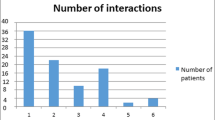Abstract
Objective: To ascertain preventable and non-preventable risk factors for adverse drug events (ADEs) in elderly inpatients at hospital admission.
Patients and methods: This was a prospective study of 2814 inpatients over 70 years of age who were consecutively admitted from November 1997 to December 1999 to a 60-bed geriatric unit of a French university hospital, and the 500 consecutive ADEs that were present at admission. All drugs administered during the month preceding hospitalisation, signs or symptoms of ADEs, and risk factors related to the drug prescription or patient’s diseases were considered: excess drug doses, potential drug-drug interactions (DDIs), interfering chronic disease and acute interfering disease.
Results: 66.7% of the ADEs were associated with cardiovascular, metabolic, renal or neuropsychological symptoms. The drugs involved were mainly cardiovascular (43.7%) and psychotropic (31.2%) drugs. One or more risk factors (mainly DDIs and/or interfering acute diseases) were recorded in 81.2% of ADEs. An interfering acute disorder (usually dehydration) was more frequent in ADEs resulting from drugs or drug combinations administered for 1 month or more (p < 0.05). 41.3% of risk factors were preventable (some DDIs, excess doses, interfering chronic diseases). One risk factor alone or the combination of all risk factors was preventable in 40.2% of ADEs.
Conclusions: This study suggests that many ADEs in the elderly may be decreased by removing all the preventable risk factors before a drug is prescribed (mainly DDIs and excess doses) and by reinforcing drug monitoring when an interfering acute disease occurs.




Similar content being viewed by others
References
Brawn LA, Castleden CM. Adverse drug reactions: an overview of special consideration in the management of the elderly patient. Drug Saf 1990; 5: 421–35
Bates DW, Cullen DJ, Laird N, et al. Incidence of adverse drug events and potential adverse drug events: implications for prevention. JAMA 1995; 274: 29–34
Lamy PP. Adverse drug effects. Clin Geriatr Med 1990; 6: 293–307
Montamat SC, Cusock B. Overcoming problems with polypharmacy and drug misuse in the elderly. Clin Geriatr Med 1992; 8: 143–58
Moore N, Lecointre D, Noblet C, et al. Frequency and cost of serious adverse drug reactions in a department of general medicine. Br J Clin Pharmacol 1998; 45: 301–8
Bates DW, Spell N, Cullen DJ, et al. The costs of adverse drug events in hospitalized patients. JAMA 1997; 277: 307–11
Classen DC, Pestotnik SL, Evans RS, et al. Adverse drug events in hospitalized patients: excess length of stay, extra costs, and attributable mortality. JAMA 1997; 277: 301–6
Lazarou J, Pomeranz BH, Corey PN. Incidence of adverse drug reactions in hospitalized patients: a meta-analysis of prospective studies. JAMA 1998; 279: 1200–5
Beers MH, Ouslander JG. Risk factors in geriatric drug prescribing: a practical guide to avoiding problems. Drugs 1989; 37: 105–12
Atkin PA, Veitch PC, Veitch EM, et al. The epidemiology of serious adverse drug reactions among the elderly. Drugs Aging 1999; 14(2): 141–52
Beyth RJ, Shorr RI. Epidemiology of adverse drug reactions in the elderly by drug class. Drugs Aging 1999; 14(3): 231–9
Hanlon JT, Weinberger M, Samsa GP, et al. A randomized, controlled trial of a clinical pharmacist intervention to improve in appropriate prescribing in elderly outpatients with polypharmacy. Am J Med 1996; 100: 428–37
Thomas EJ, Brenan TA. Incidence and types of preventable adverse events in elderly patients: population based review of medical records. BMJ 2000; 320(7237): 741–4
Doucet J, Chassagne P, Trivalle C, et al. Drug-drug interactions related to hospital admissions in older adults: a prospective study of 1000 patients. J Am Geriatr Soc 1996; 44: 944–8
Field TS, Gurwitz JH, Avorn J, et al. Risk factors for adverse drug events among nursing home residents. Arch Intern Med 2001; 161: 1629–34
Gurwitz JH, Field TS, Avorn J, et al. Incidence and preventability of adverse drug events in nursing homes. Am J Med 2000; 109: 87–94
Dictionnaire Vidal 1997. OVP: Vidal ed. Paris:, 1997
Bergman U, Wiholm BE. Drug related problems causing admission to a medical clinic. Eur J Clin Pharmacol 1981; 20: 193–200
Grymonpre RE, Mitenko PA, Sitar DS, et al. Drug-associated hospital admissions in older medical patients. J Am Geriatr Soc 1988; 36(12): 1092–8
Karch FE, Lasagna L. Adverse drug reactions: a critical review. JAMA 1975; 234(12): 1236–41
Gray SL, Soger M, Lestico MR, et al. Adverse drug events in hospitalized elderly. J Gerontol Biol Sci Med Sci 1998; 53: M59–63
Carbonin P, Pahor M, Bernabei R, et al. Is age an independent risk factor of adverse drug reactions in hospitalized medical patients? J Am Geriatr Soc 1991; 39: 1093–9
McElnay JC, McCallinan ER, Al-Deagi F, et al. Development of a risk model for adverse drug events in the elderly. Clin Drug Invest 1997; 13(1): 47–55
Cadieux RJ. Drug interactions in the elderly: how multiple drug use increases risk exponentially. Postgrad Med 1989; 86: 179–86
Avorn J, Gurwitz JH. Drug use in the nursing home. Ann Intern Med 1995; 123: 195–204
Gerety MB, Cornell JE, Plichta DT, et al. Adverse events related to drugs and drug withdrawal in nursing home residents. J Am Geriatr Soc 1993; 41: 1326–32
Beers MH. Explicit criteria for determining potentially inappropriate medication use by the elderly. Arch Intern Med 1997; 157: 1531–6
Chan M, Nicklason F, Vial JH. Adverse drug events as a cause of hospital admission in the elderly. Int Med J 2001; 31(4): 199–205
Hanlon JT, Schmader KE, Koronkowski MJ, et al. Adverse drug events in high risk older outpatients. J Am Geriatr Soc 1997; 45: 945–8
Willcox SM, Himmelstein DU, Woolhander S. Inappropriate drug prescribing for the community-dwelling elderly. JAMA 1994; 272: 292–6
Adelman AM, Daly MP, Michocki RJ. Alternate drugs. Clin Geriatr Med 1990; 6: 423–4
Author information
Authors and Affiliations
Corresponding author
Rights and permissions
About this article
Cite this article
Doucet, J., Jego, A., Noel, D. et al. Preventable and Non-Preventable Risk Factors for Adverse Drug Events Related to Hospital Admissions in the Elderly. Clin. Drug Investig. 22, 385–392 (2002). https://doi.org/10.2165/00044011-200222060-00006
Published:
Issue Date:
DOI: https://doi.org/10.2165/00044011-200222060-00006



